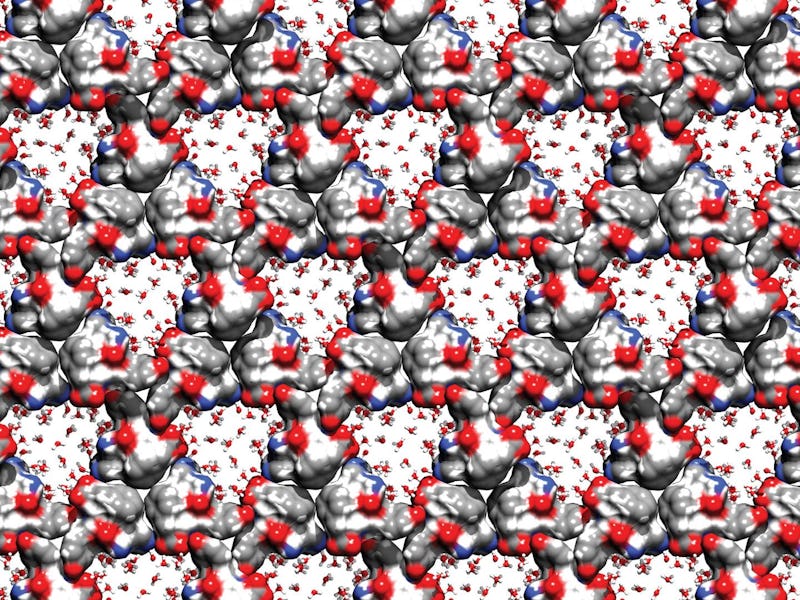Morphing water crystals could be the future of green energy
Water evaporation is among the most common transfer processes on Earth. Scientists think it could compete with solar and wind.

It’s a process so embedded in our daily lives that it’s easy to ignore. However, new research indicates there’s more to water evaporation than simply letting your towels dry in the sun after a day at the beach. Evaporation, like any form of matter transformation, requires energy.
An international team of researchers recently tried to better understand that energy process by examining the shape-shifting crystals that control it. They published their findings in Nature Materials on Monday.
The team's hope is to eventually create an energy-harvesting machine comparable to solar or wind, the study's corresponding author Xi Chen, whose lab with CUNY ASRC Nanoscience Initiative co-led the research, tells Inverse.
“We expect that the average annual power density of this energy harvesting system could be comparable to that of current solar and wind energy, but cost much less,” Chen explained over email.
How it works — The process starts with creating crystals based on variations on tripeptides, strings of amino acids that are biological building blocks.
These materials have three-dimensional patterns of nanoscale pores and between these pores, there are molecular patterns. These patterns vary between stiffness and flexibility. It’s a network built to anticipate a reaction.
Water binds to the nanoscale pores and, when humidity drops to a certain critical point, the patterns react. Water is able to escape through the nanoscale pores, leaving the molecular patterns shifting and contracting in powerful ways.
It’s a massive disruption, enough to shake the crystals out of their preset patterns and can only be set right by humidity returning. Once it returns, the crystals take their shape again, ready to start the process all over.
"It could be comparable to...current solar and wind energy, but cost much less."
This repetition, says CUNY Ph.D. student Roxana Piotrowska and the paper’s first author, is crucial to evaporation’s potential as an energy source. In a press statement she explains:
“We essentially created a new type of actuator, which is driven by water evaporation. By observing its activity we've been able to identify the fundamental mechanisms of how water-responsive materials can efficiently convert evaporation into mechanical energy."
Evaporation as an energy source — Chen has been looking into turning water evaporation, the most common form of energy transfer on the planet, into something utilitarian for over five years, with papers dating back to 2015 on the subject.
“This research was motivated by our previous invention of evaporation energy harvesting systems that directly harness energy from naturally occurring evaporation and subsequently converting the energy to mechanical energy,” he tells Inverse.
While the actuator is incredibly small, Chen has been thinking big. His previous work has demonstrated that “evaporation-driven engines that can power common tasks like locomotion and electricity generation.”
That process, as well as the process of creating this new actuator, will allow the team to better refine and understand the process of water evaporation.
The technique could have many potential uses — after all, water evaporation happens all over the globe. Oceans, seas, lakes, and rivers account for almost 90 percent of the moisture in the atmosphere through evaporation, according to the US Geological Survey.
Before the team takes the ocean's evaporation energy, however, they need to figure out how to scale it up, perhaps via a robotic nano-machine.
CUNY ASRC Nanoscience Initiative Director Rein Ulijn says in the press release that the tripeptides at the core of the new actuator will carry on to future designs:
“Our designed crystals are produced from the exact same building blocks that proteins are made of, but they are radically simplified and as a result, their properties can be precisely tuned and rationally optimized for this application. The beauty of using biological building blocks to create this new technology is that the resulting morphogenic crystals are biocompatible, biodegradable, and cost-effective.”
Abstract: Water-responsive materials undergo reversible shape changes upon varying humidity levels. These mechanically robust yet flexible structures can exert substantial forces and hold promise as efficient actuators for energy harvesting, adaptive materials and soft robotics. Here we demonstrate that energy transfer during evaporation-induced actuation of nanoporous tripeptide crystals results from the strengthening of water hydrogen bonding that drives the contraction of the pores. The seamless integration of mobile and structurally bound water inside these pores with a supramolecular network that contains readily deformable aromatic domains translates dehydration-induced mechanical stresses through the crystal lattice, suggesting a general mechanism of efficient water-responsive actuation. The observed strengthening of water bonding complements the accepted understanding of capillary-force-induced reversible contraction for this class of materials. These minimalistic peptide crystals are much simpler in composition compared to natural water-responsive materials, and the insights provided here can be applied more generally for the design of high-energy molecular actuators.